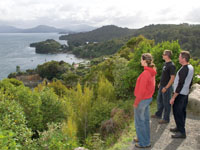 Flashlights bobbing in the night as we gingerly picked our way through the bush, all 15 of us switched off at the command of our guide Peter, leaving his the sole illumination, hopping and skipping over the remote, seaweed-strewn beach.
Flashlights bobbing in the night as we gingerly picked our way through the bush, all 15 of us switched off at the command of our guide Peter, leaving his the sole illumination, hopping and skipping over the remote, seaweed-strewn beach.
Suddenly there it was, head bobbing up and down, long beak darting in and out of the sand, single-mindedly nibbling on spiders, berries, and crustaceans: the elusive New Zealand kiwi. We waddled in muted tandem behind Peter as he inched us to within 20 feet. Trying not to intrude upon her late-night supper, we were star-struck by this little brown dumpling of a bird. It’s an experience even few Kiwis of the human variety have ever had, outside of a zoo.
You see, Stewart Island, 674 isolated square miles (1,745 sq. km) an hour’s ferry ride south of the South Island, is someplace that very few New Zealanders ever get to — much less outsiders — and is one of the few spots where it’s still possible to spot this iconic native bird.
And there are plenty of other reasons to visit Stewart, too (also sometimes known by its Maori name, Rakiura). Isolated, insular, practically undeveloped, natural, wild — it’s a destination that beckons in a way few these days still do. And yet, there’s a very lived-on, lived-in feel here, of everyday life — though probably not your kind of everyday life. Most locals get by on fishing, a spot of farming — and these days, a modest dollop of tourism. No banks, no doctors (there’s a nurse-staffed clinic, though), and, as a waitress at the Just Café told me, “no stress.” Ask how many live here, and you might hear something like: “Well, 400 at last count – no, wait – Annie just gave birth to the twins and Rupert died last week, so guess that makes 401.”
Tourism infrastructure, meanwhile, has been coming along. Start by checking in at one of a handful digs in tiny Oban town and beyond, from backpacker baracks to upscale B&B’s and rental homes. Take a peek in the Rakiura Museum. Take a glass-bottom boat ride in Half Moon Bay. Have a paddle in a sea kayak.
 But Stewart’s main draw is still its primordial nature — 85 percent is covered by NZ’s newest national park, and it’s a magical place to have a tramp and go wildlife (particularly bird) spotting. There are only some 18 miles of road, but 174 miles of walking trails, ranging from 15-minute strolls to three-hour hikes to ten-day treks.
But Stewart’s main draw is still its primordial nature — 85 percent is covered by NZ’s newest national park, and it’s a magical place to have a tramp and go wildlife (particularly bird) spotting. There are only some 18 miles of road, but 174 miles of walking trails, ranging from 15-minute strolls to three-hour hikes to ten-day treks.
I especially loved the “Maori beach track,” a 15-minute water-taxi ride from Oban. Slogging through practically impenetrable bush or hugging the craggy seaside cliff, we were bombarded in surround sound by the crashing of waves below and the cries of birds overhead. Another favorite was wee Ulva Island, also reachable by water taxi — like the “forest primeval” à la Walt Whitman’s famous poem Evangeline. Virtually untouched, predator-free, and primitive, by comparison it makes Stewart feel practically like Manhattan. Sixth-generation Stewart Islander Ulva Amos conducts marvelous tours here, able to distinguish between every caw, chirp, click, creak, twill or whistle from the treetops.
On Stewart Island you’ll find birds, trees and plants otherwise practically extinct, and its hardwood podacorp forest, literally of pre-historic vintage, harbors plant species 350 million years old. Besides the kiwi, other rare birds such as the fernbird, saddleback, rifleman and yellowhead roam the woods like in the old days.
At night, we’d hang out at the South Seas’ bar with stocking-cap-wearing men just off their fishing boats, with long beards and high boots, trying to best each other at billiards and darts. Folks drank with gusto, chortling over town gossip or bemoaning the latest catch. This is not a place that serves a lot of lite beer.
Nearby, have a peek in Glowing Sky, the T-shirt shop owned by Dil Belworthy, a former fisherman who several years ago “saw the writing on the wall, how the fishing industry was going downhill, and how we saw tourism on the horizon.” And so for the last few years, Dil’s's been turning out gorgeous tees handprinted with native Maori symbols and traditional images.
For sure, I detected a whiff of mixed emotions about this new industry of inviting the outside to their little island sanctuary. But I also got the feeling that it’s unlikely that this relic of a simpler time will lose its charm any time soon. Thank goodness.
More information: StewartIsland.co.nz, Stewart-Island-News.com, StewartIslandExperience.com.
Comments